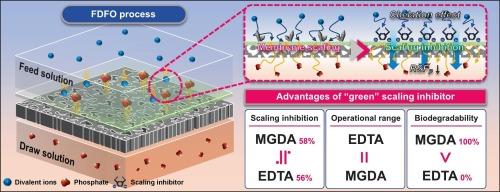评价绿色阻垢剂在肥料驱动正向渗透过程中的可行性:甲基甘氨酸二乙酸(MGDA)和谷氨酸二乙酸(GLDA)替代商用阻垢剂的应用
IF 9.8
1区 工程技术
Q1 ENGINEERING, CHEMICAL
引用次数: 0
摘要
肥料吸引正向渗透(FDFO)是一种将正向渗透(FO)建立为单一水处理方法的策略。在FDFO中,来自萃取溶液的磷酸盐被输送到进料侧,并通过与膜表面的二价离子相互作用诱导膜结垢。乙二胺四乙酸(EDTA)通常用于FDFO中防止膜结垢,但它会导致有毒金属离子排放到水系中。因此,在本研究中,根据饲料条件-阻垢剂浓度、饲料pH、温度和生物降解程度,评估甲基甘氨酸二乙酸(MGDA;二羧基甲基丙氨酸)和谷氨酸二乙酸(GLDA)作为FDFO脱盐的潜在“绿色”阻垢剂。其中,EDTA和MGDA对二价离子的螯合作用较GLDA更有效。在三种情况下(1)通过增强螯合作用和阻碍磷酸盐运输来提高阻垢剂浓度至10 ppm以上,(2)通过维持质子化磷酸盐来降低进料pH,(3)通过降低反应能来降低进料温度,FDFO可以提高通量下降比。此外,MGDA在21天内显示出100%的生物降解率,而EDTA即使在28天后也没有被微生物降解。本研究证实了MGDA在FDFO和水处理厂中具有替代EDTA的潜力,并为其应用提出了一个出色的环保操作程序。本文章由计算机程序翻译,如有差异,请以英文原文为准。

Evaluating the feasibility of green scaling inhibitors in fertilizer-driven forward osmosis process: Application of methylglycinediacetic acid (MGDA) and glutamic acid diacetate (GLDA) to replace commercial scaling inhibitors
Fertilizer-drawn forward osmosis (FDFO) is a strategy used to establish forward osmosis (FO) as a single water treatment method. In FDFO, phosphate from the draw solution is transported to the feed side and induces membrane scaling by interacting with divalent ions on the membrane surface. Ethylenediaminetetraacetic acid (EDTA) is generally applied to prevent membrane scaling in FDFO, but it can lead to the discharge of toxic metal ions into the water system. Therefore, in this study, methylglycinediacetic acid (MGDA; dicarboxymethyl alaninate) and glutamic acid diacetate (GLDA) were evaluated as potential “green” scaling inhibitors of FDFO desalination, based on feed conditions—scaling inhibitor concentration, feed pH, and temperature—and biodegradation extent. Among these, EDTA and MGDA were more effective in mitigating scale formation than GLDA because of their high chelation effect on divalent ions in batch experiments. With FDFO, the flux decline ratio was improved under the following three cases: (1) increasing the scaling inhibitor concentration to over 10 ppm by enhancing the chelation effect and hindering phosphate transport, (2) decreasing the feed pH by maintaining protonated phosphate, and (3) decreasing the feed temperature by reducing the reaction energy. Moreover, MGDA showed a 100 % biodegradation rate within 21 days, whereas EDTA was not degraded by microorganisms, even after 28 days. This study confirmed that MGDA has the potential to replace EDTA in FDFO and water treatment plants and suggested an outstanding eco-friendly operational procedure for its application.
求助全文
通过发布文献求助,成功后即可免费获取论文全文。
去求助
来源期刊

Desalination
工程技术-工程:化工
CiteScore
14.60
自引率
20.20%
发文量
619
审稿时长
41 days
期刊介绍:
Desalination is a scholarly journal that focuses on the field of desalination materials, processes, and associated technologies. It encompasses a wide range of disciplines and aims to publish exceptional papers in this area.
The journal invites submissions that explicitly revolve around water desalting and its applications to various sources such as seawater, groundwater, and wastewater. It particularly encourages research on diverse desalination methods including thermal, membrane, sorption, and hybrid processes.
By providing a platform for innovative studies, Desalination aims to advance the understanding and development of desalination technologies, promoting sustainable solutions for water scarcity challenges.
 求助内容:
求助内容: 应助结果提醒方式:
应助结果提醒方式:


